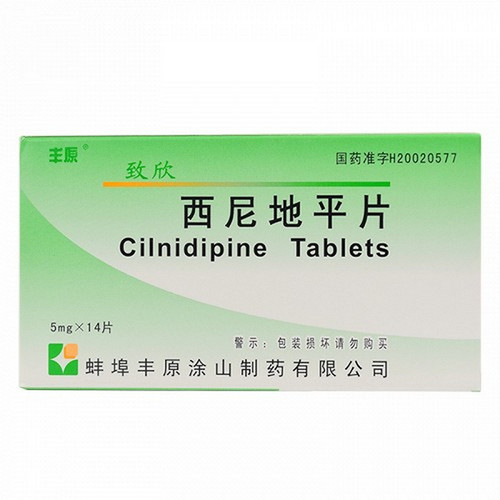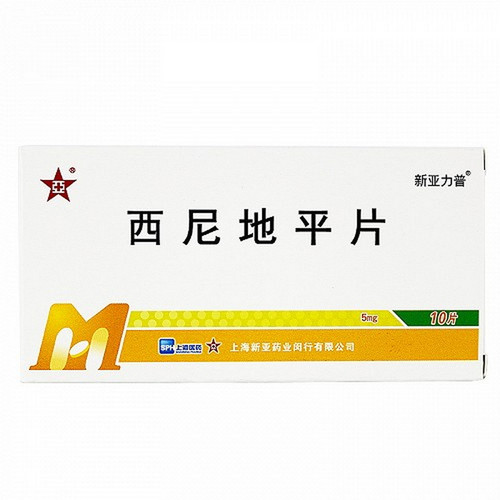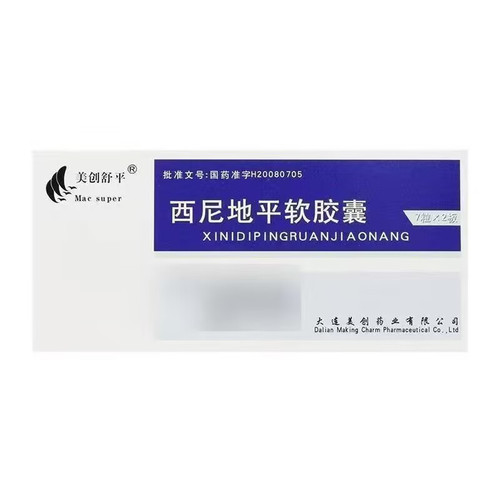Product Overview
Drug Name:
Trade Name: Tongyue
Generic Name: Cilnidipine Tablets
English Name: Cilnidipine Tablets
Indications:
For the treatment of hypertension.
Main Ingredient:
The main ingredient of this product is cilnidipine.
Specifications:
5mg*14 tablets
Interactions:
Combination Use: 1. Ephedra: It is not recommended for patients to take this product concurrently with medications containing ephedra. The ephedrine in ephedra can exacerbate symptoms of hypertension. 2. Hypericum: No clinical reports have shown interactions between this product and hypericum products. However, hypericum products share the same metabolic pathway as this product. This product is metabolized by the CYP450 enzyme system, which is a substrate for the P-glycoprotein drug transporter. Hypericum products can activate cytochrome P450 3A4 and P-glycoprotein in humans. In vitro studies have shown that hypericum extracts can inhibit cytochrome P450 isoenzymes, including P450 3A4. Therefore, calcium antagonists that can be metabolized by cytochrome P4503A4 should be avoided in combination with Hypericum products. 3. Combination with other antihypertensive drugs: This product may have an additive effect when used in combination with other antihypertensive drugs, enhancing the antihypertensive effect and potentially causing an excessive decrease in blood pressure. 4. Combination with digoxin: The combination of digoxin and calcium antagonists may increase digoxin blood concentrations and even produce symptoms of digoxin poisoning, such as nausea, vomiting, headache, visual disturbances, and arrhythmias. Adjusting the digoxin dosage or discontinuing the calcium antagonist can improve these symptoms. The possible mechanism is that calcium antagonists can reduce the renal and extrarenal clearance of digoxin. 5. Combination with cimetidine: There have been reports of enhanced effects of calcium antagonists when used in combination with cimetidine. This may be because cimetidine reduces hepatic blood flow, inhibits the enzymatic metabolism of calcium antagonists in liver microsomes, and reduces gastric acid, thereby increasing the absorption of calcium antagonists. 6. Co-administration with Rifampicin: There have been reports of decreased efficacy of calcium antagonists when used in combination with rifampicin. This may be due to rifampicin inducing hepatic enzymes, thereby promoting the metabolism of calcium antagonists and increasing their clearance. 7. Co-administration with Azo Antifungals: This product may increase plasma concentrations when used with azo antifungals (such as ketoconazole and itraconazole). This may be due to the inhibition of CYP3A4 by azo antifungals, which reduces the metabolism of this product. 8. Co-administration with Grape Juice: Certain components in grape juice can inhibit CYP3A4, reducing the metabolism of this product, leading to increased plasma concentrations of this product.
Precautions:
Elderly patients should be started with a low dose and the therapeutic response to the drug should be carefully observed. When used in combination with digoxin, close attention should be paid to digoxin toxicity. Patients with impaired liver function may experience increased plasma concentrations of cilnidipine when taking cilnidipine, so caution should be exercised. Cilnidipine is metabolized in the liver, so caution should be exercised when used concomitantly with the following medications: - Drugs that inhibit the CYP3A4 isoenzyme, such as cimetidine, ketoconazole, itraconazole, erythromycin, HIV protease inhibitors, and fluoxetine - CYP3A4 isoenzyme inducers, such as phenytoin, carbamazepine, and rifampicin - Drugs metabolized by the CYP3A4 isoenzyme, such as cyclosporine - Drugs that inhibit or induce the CYP2C19 isoenzyme - Drugs metabolized by the CYP2C19 isoenzyme, such as S-mephenytoin and omeprazole. Grape juice can increase cilnidipine plasma concentrations, so these two medications should not be used concomitantly. Women of childbearing age should use contraceptive measures during treatment. Use with caution in patients with congestive heart failure. Calcium channel blockers are not recommended for the following conditions: - Unstable angina - Myocardial infarction within the past month - Left ventricular outflow tract obstruction - Untreated congestive heart failure. Use with caution in patients with a history of serious adverse reactions to calcium channel blockers. Symptoms of sore throat may worsen at the start of treatment or when increasing the dose. Use with caution in patients with chronic renal insufficiency. Use with caution when combined with beta-blockers, especially in those with left ventricular dysfunction. During fentanyl anesthesia, it is recommended to discontinue nifedipine and other dihydropyridine derivatives 36 hours before surgery. Because abrupt discontinuation of calcium channel blockers may worsen the condition, if discontinuation is necessary, the dose should be gradually reduced and symptoms should be fully observed before discontinuation. When the dose is reduced to 5 mg, alternative medications should be used. Discontinuation should be performed under the guidance of a physician.
Dosage and Administration:
The initial dose for adults is 5 mg (one tablet) once daily, taken after breakfast. The dose may be increased based on the patient's clinical response, up to a maximum of 10 mg (two tablets per dose), once daily after breakfast.
Storage:
Store tightly closed and away from light.
Adverse Reactions:
Adverse reactions of cilnidipine are reported in some patients (approximately 6.86%) as shown in the table below: Less than 0.1% to less than 5% of patients; Less than 0.1% of patients; Urinary System: Frequent urination, increased uric acid, creatinine, uric acid nitrogen, positive urine protein, positive urine sediment; Neurological System: Headache, dizziness, shoulder muscle stiffness, drowsiness, insomnia, hand tremor, amnesia; Circulatory System: Flushing, palpitations, hot flashes, ECG abnormalities (ST segment depression, T wave reversal), hypotension, chest pain, chills, premature contractions, sexual dysfunction; Digestive System: AST, ALT, y Liver function abnormalities such as elevated β-GTP, vomiting, abdominal pain, thirst, constipation, and abdominal distension; abnormal white blood cell and neutrophil counts, thrombocytopenia, abnormal red blood cells, hematocrit, eosinophils, and lymphocytes; allergic drug rash; pruritus; other symptoms; edema; fatigue; elevated serum cholesterol; abnormal serum K and P levels; dry eyes, congestion, gastrocnemius cramps, abnormal taste; positive urine glucose; abnormal fasting blood glucose, total protein, serum calcium, and CRP levels. If any of the above abnormalities occur, consult a doctor promptly and take appropriate measures.
Interactions:
Combination Use:
1. Ephedra: Clinically, it is not recommended that patients take this product concurrently with medications containing ephedra. The ephedrine in ephedra can exacerbate symptoms of hypertension.
2. Hypericum: There have been no clinical reports of interactions between this product and hypericum products. However, hypericum products share the same metabolic pathway as this product. This product is metabolized by the CYP450 enzyme system, which is a substrate for the P-glycoprotein drug transporter. Hypericum wilfordii extracts can activate cytochrome P450 3A4 and P-glycoprotein in humans. In vitro studies have shown that hypericum wilfordii extracts can inhibit cytochrome P450 isoenzymes, including P450 3A4. Therefore, calcium antagonists, which are metabolized by cytochrome P450 3A4, should be avoided in combination with hypericum wilfordii extracts.
3. Combination with other antihypertensive drugs: This product may have an additive effect when used with other antihypertensive drugs, enhancing the antihypertensive effect and potentially causing excessive lowering of blood pressure.
4. Combination with digoxin: The combined use of digoxin and calcium antagonists may increase digoxin blood concentrations and even produce symptoms of digoxin toxicity, such as nausea, vomiting, headache, visual disturbances, and arrhythmias. Adjusting the digoxin dosage or discontinuing the calcium antagonist can improve these symptoms. This may be due to the fact that calcium antagonists reduce the renal and extrarenal clearance of digoxin. 5. Concomitant Use with Cimetidine: There have been reports of enhanced effects of calcium antagonists when used in combination with cimetidine. This may be due to cimetidine reducing hepatic blood flow, inhibiting the enzymatic metabolism of calcium antagonists in liver microsomes, and reducing gastric acid, thereby increasing calcium antagonist absorption.
6. Concomitant Use with Rifampicin: There have been reports of decreased effects of calcium antagonists when used in combination with rifampicin. This may be due to rifampicin inducing hepatic enzymes, thereby promoting the metabolism of calcium antagonists and increasing their clearance.
7. Concomitant Use with Azo Antifungals: This product may increase plasma concentrations when used in combination with azo antifungals (such as ketoconazole and itraconazole). This may be due to azo antifungals inhibiting CYP3A4 and reducing the metabolism of this product.
8. Concomitant Use with Grape Juice: Certain components in grape juice may inhibit CYP3A4, reducing the metabolism of this product, thereby increasing the plasma concentration of this product.
Contraindications:
1. This product is contraindicated in patients with allergies to any component of this product. 2. Not for use by pregnant women.
3. Due to the risk of hypotension, this product should not be used when working at heights, operating a motor vehicle, or operating machinery.
Manufacturer:
Shanxi Zhendong Taisheng Pharmaceutical Co., Ltd.







